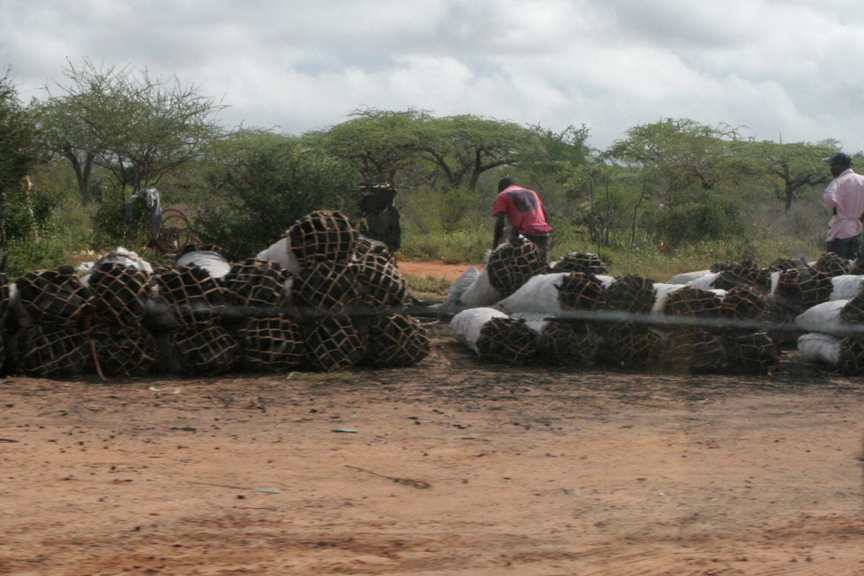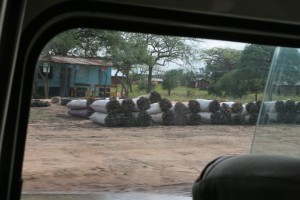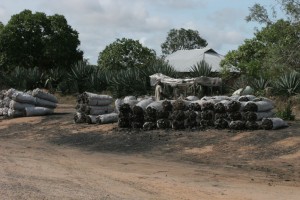 You may have read my recent blog post about woodcarving traditions carried on by Kamba tribesmen in Kenya. I’ll call that the highlight of my “wood-related” African travelog.
You may have read my recent blog post about woodcarving traditions carried on by Kamba tribesmen in Kenya. I’ll call that the highlight of my “wood-related” African travelog.
There was a lowlight, too: charcoal production. Its carbonized and troubling evidence was stacked in bags along the highways wherever we went.
As you probably know, Kenya is a developing country. It’s saddled with unemployment and struggling to recover the effects of several years of intense drought. Most Kenyans still fuel their cooking stoves with charcoal. One article I read that was published in EcoForum Magazine in 2002 estimated that 82% of the population depends on charcoal for fuel. Even so, charcoal production is an unregulated industry. While the Kenyan government considers the production and transportation of charcoal to be illegal in most parts of the country, there is no other widely available and affordable fuel source, especially in large cities. So, despite bans against producing it, underground cartels make staggering quantities of charcoal each year—most of which comes from unmanaged indigenous forests that are virtually clearcut and burned. There’s no economic incentive to replant the trees that are lost, and the government doesn’t subsidize reforestation for an illegal industry.
 Making charcoal is a labor-intensive process. A fire is built at the base of a tree to kill it, or it’s felled with an axe. The tree is chopped into pieces, allowed to dry for a week or so and stacked in a mound. Then it’s covered with a layer of grass and sod to form an airtight kiln. An opening is made at the base to allow just enough air inside to support a fire that carbonizes the wood but doesn’t turn it to ash. The process takes a week or two to complete, and no suitable tree is spared. Any solid tree that is about as thick as your arm or larger is fair game. African mahogany, rosewoods, ebony, acacia; the species doesn’t matter.
Making charcoal is a labor-intensive process. A fire is built at the base of a tree to kill it, or it’s felled with an axe. The tree is chopped into pieces, allowed to dry for a week or so and stacked in a mound. Then it’s covered with a layer of grass and sod to form an airtight kiln. An opening is made at the base to allow just enough air inside to support a fire that carbonizes the wood but doesn’t turn it to ash. The process takes a week or two to complete, and no suitable tree is spared. Any solid tree that is about as thick as your arm or larger is fair game. African mahogany, rosewoods, ebony, acacia; the species doesn’t matter.
This same article estimated that Kenyans were burning about 2.4 million tons of charcoal every year, with the government largely turning a blind eye to it. I can only imagine that that statistic has grown since ’02. To make matters worse, it’s an inefficient fuel source, requiring 6 to 8 tons of wood to produce a single ton of charcoal.
Rampant unemployment, failed crops or ranching and other hardships force many impoverished Kenyans into the charcoal production trade. They sell bag after bag of it for a fraction of its “street” value to transporters that move it into big cities like Mombasa and Nairobi—largely by dark of night. Those who are wealthy enough to buy it by the bag get the best value, but bags are usually parceled into much smaller quantities and sold at an inflated price to those unable to buy in larger volume.  Consequently, profits end up in the pockets of those that control the cartels. And, charcoal continues to be the “poor man’s” fuel of necessity, made predominantly by people who are also very poor.
Consequently, profits end up in the pockets of those that control the cartels. And, charcoal continues to be the “poor man’s” fuel of necessity, made predominantly by people who are also very poor.
Some efforts have been made in recent years to develop more efficient charcoal-burning stoves, and those initiatives have even received governmental support. But the charcoal cartels continue, unregulated and untaxed, stripping more forested land each year.
Those stacked bags of charcoal waiting for market were a troubling sight to see, especially since I know so little about what is clearly a complex national and environmental issue. I guess that’s the blessing and bane of travel…it takes you outside your comfort zone, but sometimes in ways that can be both sobering and very difficult to comprehend.
Catch you in the shop,
Chris Marshall, Field Editor






